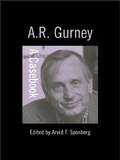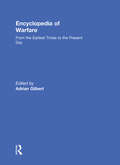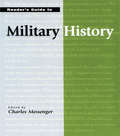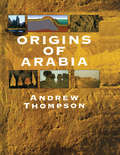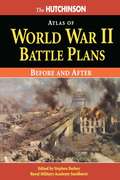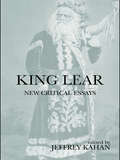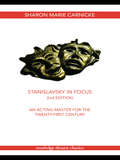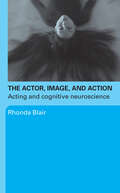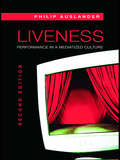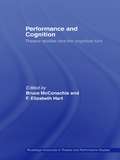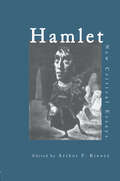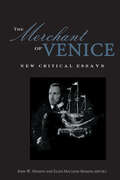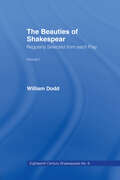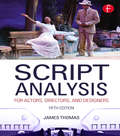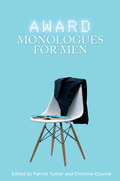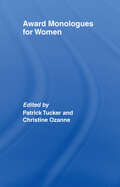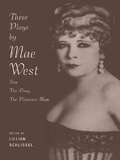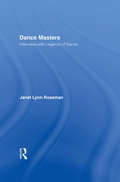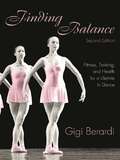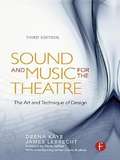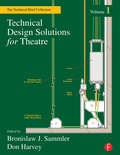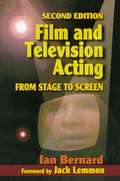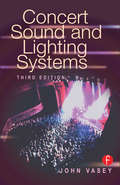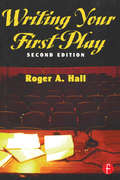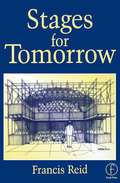- Table View
- List View
A.R. Gurney: A Casebook (Casebooks on Modern Dramatists #34)
by Arvid F. SponbergThis is the first full-length study devoted to the art of A.R. Gurney, a major contemporary American playwright who has written over thirty plays, including Love Letters. This volume brings together original interviews with Gurney and four actors and a director who have worked closely with him, as well as essays by leading theater scholars on the range of Gurney's work.
Encyclopedia of Warfare: From the Earliest Times to the Present Day
by Adrian GilbertThe Encyclopedia of Warfare is a chronological account of the development of warfare since the beginnings of recorded history. The book is organized in 10 chapters, each of which looks at a particular era in warfare from the ancient world to the present. Each chapter includes color maps of key campaigns, as well as commentary on battles, personalities, troops, and equipment. Sidebars throughout the main narrative focus on noteworthy aspects of the history of conflict. Through its chronological organization and ample use of maps, the Encyclopedia also clearly conveys the link between war and world geographical history. A thorough yet concise exploration of combat throughout human history, this fascinating and informative reference work is an outstanding addition to any library collection.
Reader's Guide to Military History (Reader's Guiides Ser.)
by Charles MessengerThis book contains some 600 entries on a range of topics from ancient Chinese warfare to late 20th-century intervention operations. Designed for a wide variety of users, it encompasses general reviews of aspects of military organization and science, as well as specific wars and conflicts. The book examines naval and air warfare, as well as significant individuals, including commanders, theorists, and war leaders. Each entry includes a listing of additional publications on the topic, accompanied by an article discussing these publications with reference to their particular emphases, strengths, and limitations.
Origins of Arabia
by Andrew ThompsonFirst Published in 2000. Routledge is an imprint of Taylor & Francis, an informa company.
The Hutchinson Atlas of World War II Battle Plans: Before And After
by Stephen BadseyThis text contrasts 21 World War II battle plans with their actual outcome. Each in-depth battle essay is complemented by original maps, producing fresh insight into the technical aspects of warfare that drove the last worldwide conflict of the 20th century. An overall introduction gives a strategic overview of the whole of the war, and places the individual battles into context. The battles are presented in seven groups of three, and each group is introduced by a short essay on the common theme for the group.
King Lear: New Critical Essays (Shakespeare Criticism)
by Jeffrey KahanIs King Lear an autonomous text, or a rewrite of the earlier and anonymous play King Leir? Should we refer to Shakespeare’s original quarto when discussing the play, the revised folio text, or the popular composite version, stitched together by Alexander Pope in 1725? What of its stage variations? When turning from page to stage, the critical view on King Lear is skewed by the fact that for almost half of the four hundred years the play has been performed, audiences preferred Naham Tate's optimistic adaptation, in which Lear and Cordelia live happily ever after. When discussing King Lear, the question of what comprises ‘the play’ is both complex and fragmentary. These issues of identity and authenticity across time and across mediums are outlined, debated, and considered critically by the contributors to this volume. Using a variety of approaches, from postcolonialism and New Historicism to psychoanalysis and gender studies, the leading international contributors to King Lear: New Critical Essays offer major new interpretations on the conception and writing, editing, and cultural productions of King Lear. This book is an up-to-date and comprehensive anthology of textual scholarship, performance research, and critical writing on one of Shakespeare's most important and perplexing tragedies. Contributors Include: R.A. Foakes, Richard Knowles, Tom Clayton, Cynthia Clegg, Edward L. Rocklin, Christy Desmet, Paul Cantor, Robert V. Young, Stanley Stewart and Jean R. Brink
Stanislavsky in Focus: An Acting Master for the Twenty-First Century
by Sharon Marie CarnickeFirst published in 1998. Routledge is an imprint of Taylor & Francis, an informa company.
The Actor, Image, and Action: Acting and Cognitive Neuroscience
by Rhonda BlairThe Actor, Image and Action is a 'new generation' approach to the craft of acting; the first full-length study of actor training using the insights of cognitive neuroscience. In a brilliant reassessment of both the practice and theory of acting, Rhonda Blair examines the physiological relationship between bodily action and emotional experience. In doing so she provides the latest step in Stanislavsky's attempts to help the actor 'reach the unconscious by conscious means'. Recent developments in scientific thinking about the connections between biology and cognition require new ways of understanding many elements of human activity, including: imagination emotion memory physicality reason. The Actor, Image and Action looks at how these are in fact inseparable in the brain's structure and function, and their crucial importance to an actor’s engagement with a role. The book vastly improves our understanding of the actor's process and is a must for any actor or student of acting.
Liveness: Performance in a Mediatized Culture
by Philip AuslanderLiveness: Performance in a Mediatized Culture addresses what may be the single most important question facing all kinds of performance today. What is the status of live performance in a culture dominated by mass media? Since its first appearance, Philip Auslander's ground-breaking book has helped to reconfigure a new area of study. Looking at specific instances of live performance such as theatre, rock music, sport, and courtroom testimony, Liveness offers penetrating insights into media culture, suggesting that media technology has encroached on live events to the point where many are hardly live at all. In this new edition, the author thoroughly updates his provocative argument to take into account new digital and media technologies, and cultural, social and legal developments. In tackling some of the last great shibboleths surrounding the high cultural status of the live event, this book will continue to shape discussion and to provoke lively debate on a crucial artistic dilemma: what is live performance and what can it mean to us now?
Performance and Cognition: Theatre Studies and the Cognitive Turn (Routledge Advances in Theatre & Performance Studies)
by Bruce McConachie F. Elizabeth HartThis anthology is the first of its kind. In addition to opening up fresh perspectives on theatre studies – with applications for dramatic criticism, performance analysis, acting practice, audience response, theatre history, and other important areas – the book sets the agenda for future work, helping to map the emergence of this new approach. Following a comprehensive introduction, the contributors examine: the interfaces between cognitive studies and Lacanian psychoanalysis, phenomenology and communication theory different ideas from cognitive studies that open up the meanings of several plays the process of acting and the work of Antonio Damasio theatrical response: the dynamics of perception, and the riots that greeted the 1907 production of The Playboy of the Western World. This original and authoritative work will be attractive to scholars and graduate students of drama, theatre, and performance.
Hamlet: Critical Essays (Shakespeare Criticism)
by Arthur F. KinneyUsing a variety of approaches, from postcolonialism and New Historicism to psychoanalysis and gender studies, the international contributors to Hamlet: New Critical Essays contribute major new interpretations on the conception and writing, editing, and cultural productions of Hamlet. This book is the most up-to-date and comprehensive critical analysis available of one of Shakespeare's best-known and most engaging plays.
The Merchant of Venice: Critical Essays (Shakespeare Criticism #26)
by John W. Mahon Ellen Macleod MahonThis volume is a collection of all-new original essays covering everything from feminist to postcolonial readings of the play as well as source queries and analyses of historical performances of the play. The Merchant of Venice is a collection of seventeen new essays that explore the concepts of anti-Semitism, the work of Christopher Marlowe, the politics of commerce and making the play palatable to a modern audience. The characters, Portia and Shylock, are examined in fascinating detail. With in-depth analyses of the text, the play in performance and individual characters, this book promises to be the essential resource on the play for all Shakespeare enthusiasts.
Beauties of Shakespeare Cb: Eighteenth Century Shakespeare Volume 9 - 2 Volumes
by William DoddFirst published in 2005. Routledge is an imprint of Taylor & Francis, an informa company.
Script Analysis for Actors, Directors, and Designers
by James ThomasScript Analysis for Actors, Directors, and Designers teaches the skills of script analysis using a formalist approach that examines the written part of a play to gauge how the play should be performed and designed. Treatments of both classic and unconventional plays are combined with clear examples, end-of-chapter questions, and stimulating summaries that will allow actors, directors and designers to immediately incorporate the concepts and processes into their theatre production work. Now thoroughly revised, the fifth edition contains a new section on postmodernism and postdramatic methods of script analysis, along with additional material for designers.
Award Monologues for Men
by Patrick Tucker Christine OzanneAward Monologues for Men is a collection of fifty monologues taken from plays written since 1980 that have been nominated for the Pullitzer Prize, the Tony and the Drama Desk Awards in New York, and The Evening Standard and Laurence Olivier Awards in London. The book provides an excellent range of up-to-date audition pieces, usefully arranged in age groups, and is supplemented with audition tips to improve your acting, and to ensure you give your best possible performance.
Award Monologues for Women
by Patrick Tucker Christine OzanneAward Monologues for Women is a collection of fifty-four monologues taken from plays written since 1980 that have been nominated for the Pullitzer Prize, the Tony and the Drama Desk Awards in New York, and The Evening Standard and Laurence Olivier Awards in London. The book provides an excellent range of up-to-date audition pieces, usefully arranged in age groups, and is supplemented with audition tips to improve your acting, and to ensure that the best possible performance.
Three Plays by Mae West: Sex, The Drag and Pleasure Man
by Lillian SchlisseMae West, wise-cracking vaudeville performer, was one of the most controversial figures of her era. Rarely, however, do people think of Mae West as a writer. In Three Plays By Mae West, Lillian Schlissel brings this underexplored part of West's career to the fore by offering for the first time in book form, three of the plays West wrote in the 1920s--Sex (1926), The Drag (1927) and Pleasure Man (1928). With an insightful introduction by Schlissel, this book offers a unique look into to the life and early career of this legendary stage and screen actress.
Dance Masters: Interviews with Legends of Dance
by Janet Lynn RosemanDance Masters is a lively ensemble of conversations with seven celebrated dancers and choreographers. In these intimate interviews, dance critic Janet Lynn Roseman probes the heart of dance: * The creative process * The role of dream and rituals * The interplay between dancer and audience * The spiritual aspects of performance These dance masters offer rare insights into the internal world of the artist as they reveal their philosophies on dance training, discuss their mentors, and speak candidly about the artistic process of dance-making and how it actually feels to dance.
Finding Balance: Fitness, Training, and Health for a Lifetime in Dance
by Gigi BerardiFinding Balance: Fitness, Health, and Training for a Lifetime in Dance gives an overview of issues faced by all performing dancers: injury and treatment; technique and training; fitness; nutrition and diet; and career management. The text includes both easy-to-read overviews of each topic and "profiles" of well known dancers and how they have coped with these issues. The new edition includes: Updated and new profiles. Expanded injury and injury treatment information. Updated dance science and physiology findings, and new references. Updated diet guidelines, Expanded and updated "Taking Control" section. It concludes with a list of selected dance/arts medicine clinics, a bibliography, glossary, and text notes.
Sound and Music for the Theatre
by Deena Kaye James LebrechtThe same loved book you've been using for years - now including everything you need to know about sound design for the theatre. This edition still focuses on aesthetics of sound design for the stage along with design approaches and techniques. You'll still get the in-depth discussion with leading sound designers and composers to see how the experts get the job done.BUT, this new third edition has swept out the old to bring you the new! Now included is all of the latest technical information that you will need including:*Information about Digital Audio Workstations as everyday tools for sound effects*Maximizing the Internet and computer as a major, important, every day tool for today's sound designers and also composer? as a 24-hour library*new roundtable forum discussion with sound reinforcement designers that uncovers the way they make and communicate aesthetic decision*A fresh look at technology used to build and execute shows (digital audio workstations, software, and your computer as creative management tool)*Everyday paperwork'new examples for sound plots and queue sheets to increase the variety of examples and so you can pick your best fit
Technical Design Solutions for Theatre: The Technical Brief Collection Volume 1
by Don Harvey Bronislaw J. SammlerThe Technical Brief is a collection of single-focus articles on technical production solutions, published three times a year by the prestigious Yale School of Drama. The primary objective of the publication is to share creative solutions to technical problems so that fellow theatre technicians can avoid having to reinvent the wheel with each new challenge. The range of topics includes scenery, props, painting, electrics, sound, and costumes. The articles each describe an approach, device, or technique that has been tested on stage or in a shop by students and professionals. Some articles included: Growing Flowers on Stage; Break-Away Glass; Photo-Murals for the Stage; Quiet Wire-Rope Curtain Track; Free Standing Curved Stairs; A Measured Approach to Kerfing; A Low-Voltage Remote Controller for Special Effects; Toggle-Clamp Locks; Comparing Four Plastics as Scenery Glides; Low Pressure Air Casters; A Simple Lift Jack; Using a Piano to Create a Reverberation Effect; Horn-Hat Mics for Sound Reinforcement
Film and Television Acting: From stage to screen
by Ian BernardFilm and Television Acting offers solid techniques for creating a natural, believable performance for film and television. The reader will discover techniques for listening and reacting, blocking and business, character, focus, the closeup, and comedy as they pertain to acting in front of a camera. The book analyzes the differences between theatre, film, and television acting, providing the theatre trained actor with specific approaches for making the transition to on-camera work. This second edition is thoroughly revised and updated. The book contains numerous scenes and exercises, including sample scenes from Cheers and Seinfeld, which provide the reader with ways to practice the specific techniques outlined by the author. Included are interviews with well-know actors and directors: Don Murray, Norman Jewison, and Emmy award winner, Glenn Jordan, to name a few. These interviews illustrate how the professionals apply their training and technique to filmed performances. There is also a chapter-length interview with John Lithgow, in which the actor provides a first-hand account of the differences of acting for the theatre and for the camera.
Concert Sound and Lighting Systems
by John VaseyConcert Sound and Lighting Systems provides comprehensive coverage of equipment and setup procedures for touring concert systems. The new edition will cover the new equipment now available and discuss other venues where the skills and technology are being used. This new edition incorporates the continuing developments in concert sound and lighting systems maintaining the premise that the reader has had no previous experience. The practical how-to illustrations teach the reader about the equipment, and this thoroughly updated edition will include new equipment such as radio microphones, in-ear monitoring, digital audio products and digital lighting products. The author also discusses new venues outside thetraditional concert touring environment and applies the skills and technology to such diverse events as product launches, theatrical arena spectaculars and outdoor stadium productions. In addition to an introductory section on touring concerts, there are sections on sound systems and lighting systems and an explanation of how all the parts fit together to create a professional, safe, efficient show.
Writing Your First Play
by Roger HallWriting Your First Play provides the beginning playwright with the tools and motivation to tell a story through dramatic form. Based in a series of exercises which gradually grow more complex, the books helps the reader to understand the basic elements of drama, conflict, and action. The exercises help the reader to become increasingly sophisticated in the use of dramatic formats, turning simple ideas into a viable play. Topics include: the role of action in drama;developing action and conflict to reveal character;writing powerful and persuasive dialog;writing from personal experience:pros and cons;how to begin the story and develop the storyline. This new edition is thoroughly updated and contains new examples based on contemporary plays. The author has added additional writing exercises and a new student-written one act play. It also contains a new chapter on how to sell your play once it is written.With examples based on student work, this text both inspires and educates the student and fledgling playwright, providing solid tools and techniques for the craft of writing a drama. Roger A. Hall, a professor of theatre at James Madison University, had taught playwriting for nearly 20 years. Many of his students have gone on to write for theatre, television, and the screen. He has written numerous plays and articles and has acted and directed extensively in the theatre.
Stages for Tomorrow: Housing, funding and marketing live performances
by Francis ReidThroughout the twentieth century, live theatre has been challenged by a range of new media based on increasingly sophisticated technologies. In Stages for Tomorrow, Francis Reid, one of the world's best known and best loved lighting designers, gives a unique insight into some of the key developments of live performance technology this century and offers a view of where the future lies - a must for any theatre professional who takes their job seriously. Throughout the twentieth century, live theatre has been challenged by a range of new media based on increasingly sophisticated technologies - audio recording, film, radio, television, video recording - and it has survived them all. Now live performance faces an information technology explosion where the reality is claimed to be virtual. In Stages for Tomorrow, Francis Reid, one of the world's best known and best loved lighting designers, gives a unique insight into some of the key developments of live performance technology this century and offers a view of where the future lies - a must for any theatre professional who takes their job seriously. The book covers every aspect of staging a live performance: from its relationship with photographic and digital media, old and new, to factors affecting the architectural design of buildings which house performances of ephemeral arts. The technology of staging styles is covered, with ongoing engineering solutions for scenery, light and sound. The book also examines developments in costume design, marketing and training. Whether student or seasoned professional - this is a guide to the technical theatre that you won't want to be without - now, or in the future!
